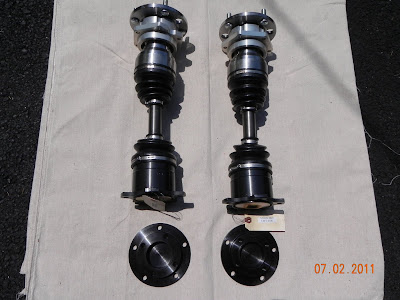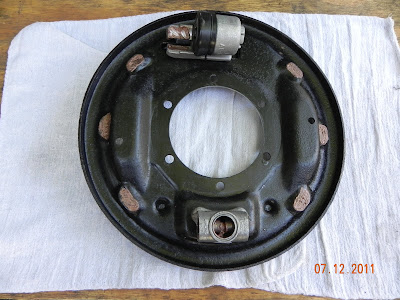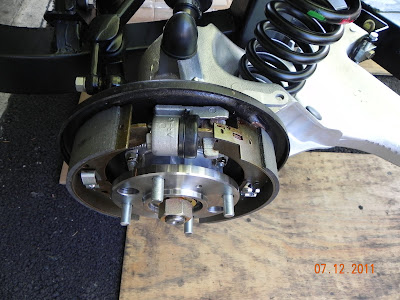Keeping with my "upgrade when possible" policy, I decided to replace both the hubs and axles with Good Parts "Axle and Hub Assembly with CV Joints". They are not cheap, but 40 year old axles do suffer from metal fatigue, so why risk it. Besides, Richard's parts are just plain gorgeous!
This is pretty much a direct bolt- in replacement for the stock parts, but you do need to check for clearance on the inside of the trailing arms. In my case, there were casting ridges that needed to be smoothed off. A flap sander / drill combo made the job pretty easy. The driver's side T/A proved to be the problem , and I ended up pulling the axle/hub assembly out several times until enough material was removed to stop the axle boot from rubbing.
Because I'm using the stock differential, I needed an adapter plate to be bolted to the diff.....
One nice thing about doing these upgrades during a restoration is that I have easy access ,and I didn't need to pull off the trailing arms or differential like those folks who are working with the body still on the frame.
Bolts still need to be torqued, but the hub/axles fit, so let's get the rear brakes in place.
Another small upgrade I've included is replacing the stock rear brake cylinders (top of pix) with "Morgan" cylinders that have a larger 7/8" bore for more rear stopping power. I cleaned and reused the rear brake adjusters (bottom of pix) after 6-Pack member Brosky experienced a failure with new replacement parts. As usual, Brosky provided clear directions on how to clean and re-install the original adjuster. Thanks Paul !
Following the Bently manual, plus some trial and error, I had the rear brakes assembled, so lets put them back on the trailing arm !
Slide the hub off, then slip the rear brake backing plate over the 6 studs, slide the hub back on, and secure with the nylock nuts. Torque to 16 lb ft. and we're looking good!
I painted the rear drums with a high heat paint from the folks at POR. The drums appear to be in good shape with no wear ridges, so back on they go.
Note that the 22mm locking axle nuts require 250 lb ft of torque, so they will not be installed until the brake system is back in place and wifey can press on the brake pedal while I use the torque wrench ! I'm using non-locking nuts just to keep things together during the restoration.
Another small segment put back together !


































